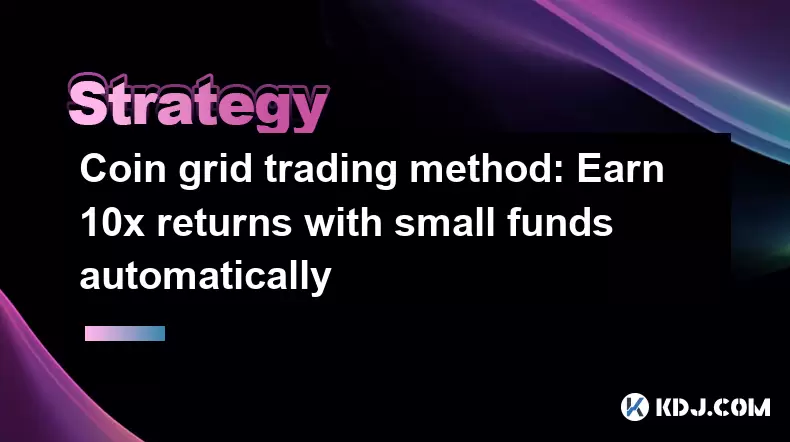-
 bitcoin
bitcoin $114320.977035 USD
-0.40% -
 ethereum
ethereum $4152.439985 USD
-1.75% -
 tether
tether $1.000111 USD
-0.04% -
 xrp
xrp $2.843037 USD
-1.63% -
 bnb
bnb $1013.349380 USD
-1.62% -
 solana
solana $208.362767 USD
-2.10% -
 usd-coin
usd-coin $0.999783 USD
0.00% -
 dogecoin
dogecoin $0.232559 USD
-1.00% -
 tron
tron $0.333491 USD
-1.09% -
 cardano
cardano $0.806310 USD
0.19% -
 hyperliquid
hyperliquid $45.023720 USD
-1.59% -
 ethena-usde
ethena-usde $1.000819 USD
-0.06% -
 chainlink
chainlink $21.241249 USD
-2.11% -
 avalanche
avalanche $30.035416 USD
-0.66% -
 stellar
stellar $0.364984 USD
-2.05%
Coin grid trading method: Earn 10x returns with small funds automatically
Coin grid trading automates buying low and selling high within set price ranges, enabling potential 10x returns on small investments through market volatility.
Jun 08, 2025 at 11:15 am

Coin grid trading is an automated trading strategy that allows traders to potentially earn significant returns using small funds. This method involves setting up a grid of buy and sell orders at predetermined price levels, which enables traders to profit from the volatility of the cryptocurrency market. In this article, we will explore the coin grid trading method in detail and discuss how it can help you achieve 10x returns with small funds automatically.
Understanding the Basics of Coin Grid Trading
Coin grid trading is based on the concept of buying low and selling high within a specific price range. Traders set up a grid of buy and sell orders at evenly spaced intervals within this range. When the price of the cryptocurrency falls to a buy order level, the system automatically executes a purchase. Conversely, when the price rises to a sell order level, the system executes a sale. This process repeats as the price fluctuates within the grid, allowing traders to accumulate profits from each transaction.
The key to earning 10x returns with small funds lies in the automation and consistency of the grid trading strategy. By setting up the grid correctly and letting the system run automatically, traders can take advantage of market volatility without the need for constant monitoring or manual intervention.
Setting Up a Coin Grid Trading Strategy
To implement a coin grid trading strategy, you need to follow a series of steps to set up your grid. Here's how you can do it:
Choose a suitable cryptocurrency: Select a cryptocurrency that exhibits sufficient volatility within your desired trading range. Popular choices include Bitcoin (BTC), Ethereum (ETH), and other major altcoins.
Determine the trading range: Identify the upper and lower boundaries of your trading range based on historical price data and market analysis. The range should be wide enough to capture significant price movements but not so wide that it becomes difficult to manage.
Set the grid intervals: Divide the trading range into equal intervals. The number of intervals will depend on your risk tolerance and the size of your initial investment. More intervals can lead to more frequent trades but may also increase transaction costs.
Define the buy and sell orders: Place buy orders at the lower end of each interval and sell orders at the upper end. The quantity of each order should be calculated based on your total investment and the number of intervals.
Configure the trading bot: Use a trading platform or bot that supports grid trading, such as Binance, KuCoin, or 3Commas. Input your trading parameters, including the cryptocurrency, trading range, grid intervals, and order quantities. Ensure that the bot is set to execute trades automatically based on the grid.
Optimizing Your Coin Grid Trading Strategy
To maximize your returns and minimize risks, it's essential to optimize your coin grid trading strategy. Here are some tips to help you achieve this:
Adjust the grid intervals: Depending on market conditions, you may need to adjust the number and size of your grid intervals. In highly volatile markets, smaller intervals can help you capture more price movements, while larger intervals may be more suitable for less volatile markets.
Monitor and rebalance: Although the grid trading system is automated, it's crucial to monitor its performance and make adjustments as needed. Rebalance your grid by adding or removing intervals, adjusting the trading range, or reallocating your funds based on market trends.
Manage transaction costs: Be mindful of the transaction fees associated with each trade. High-frequency trading can lead to significant costs, so consider using platforms with low fees or optimizing your grid to reduce the number of transactions.
Diversify your portfolio: To mitigate risks, consider diversifying your coin grid trading across multiple cryptocurrencies. This can help you spread your investments and potentially increase your overall returns.
Case Study: Achieving 10x Returns with Coin Grid Trading
Let's explore a hypothetical case study to illustrate how coin grid trading can help you achieve 10x returns with small funds. Assume you have an initial investment of $1,000 and choose to trade Bitcoin within a range of $30,000 to $40,000.
Set up the grid: Divide the trading range into 10 intervals, with buy orders at $30,000, $31,000, $32,000, and so on, and sell orders at $30,500, $31,500, $32,500, and so on.
Execute trades: As the price of Bitcoin fluctuates within the grid, the system automatically buys and sells at the predetermined levels. Let's assume the price moves from $30,000 to $40,000 and back to $30,000 over a period of time.
Calculate profits: With each complete cycle of the grid, you make a profit of $500 (10 intervals x $50 per interval). If the price completes five cycles within the grid, your total profit would be $2,500.
Achieve 10x returns: With an initial investment of $1,000, a total profit of $2,500 represents a 250% return. By reinvesting your profits and expanding your grid, you can continue to compound your returns and potentially achieve 10x returns over time.
Risks and Considerations in Coin Grid Trading
While coin grid trading offers the potential for significant returns, it's essential to be aware of the risks and considerations involved. Here are some key points to keep in mind:
Market volatility: Cryptocurrency markets can be highly volatile, which can lead to rapid price movements outside your trading range. If the price moves beyond your grid, you may miss out on potential profits or incur losses.
Transaction costs: Frequent trading within the grid can result in high transaction fees, which can eat into your profits. It's crucial to choose a platform with low fees and optimize your grid to minimize the number of transactions.
Liquidity risks: In less liquid markets, there may be insufficient trading volume to execute your orders at the desired price levels. This can lead to slippage and reduced profitability.
Technical issues: Relying on automated trading bots and platforms introduces the risk of technical failures or errors. Ensure that you have backup systems in place and monitor your trades closely to mitigate these risks.
Frequently Asked Questions
Q: Can I use coin grid trading with any cryptocurrency?A: While coin grid trading can be applied to any cryptocurrency, it is most effective with assets that exhibit sufficient volatility within a defined trading range. Major cryptocurrencies like Bitcoin and Ethereum are popular choices due to their liquidity and price fluctuations.
Q: How do I choose the right trading range for my grid?A: Selecting the right trading range involves analyzing historical price data and market trends. The range should be wide enough to capture significant price movements but not so wide that it becomes difficult to manage. Consider using technical analysis tools and market indicators to help you make informed decisions.
Q: Is it possible to lose money with coin grid trading?A: Yes, it is possible to lose money with coin grid trading, especially if the price moves outside your trading range or if transaction costs are high. It's essential to carefully manage your risks and monitor your trades to minimize potential losses.
Q: Can I combine coin grid trading with other trading strategies?A: Yes, you can combine coin grid trading with other strategies, such as trend following or swing trading, to diversify your approach and potentially increase your returns. However, be mindful of the complexity and potential risks associated with combining multiple strategies.
Disclaimer:info@kdj.com
The information provided is not trading advice. kdj.com does not assume any responsibility for any investments made based on the information provided in this article. Cryptocurrencies are highly volatile and it is highly recommended that you invest with caution after thorough research!
If you believe that the content used on this website infringes your copyright, please contact us immediately (info@kdj.com) and we will delete it promptly.
- BlockDAG, DOGE, HYPE Sponsorship: Crypto Trends Shaping 2025
- 2025-10-01 00:25:13
- Deutsche Börse and Circle: A StableCoin Adoption Powerhouse in Europe
- 2025-10-01 00:25:13
- BlockDAG's Presale Buzz: Is It the Crypto to Watch in October 2025?
- 2025-10-01 00:30:13
- Bitcoin, Crypto, and IQ: When Genius Meets Digital Gold?
- 2025-10-01 00:30:13
- Stablecoins, American Innovation, and Wallet Tokens: The Next Frontier
- 2025-10-01 00:35:12
- NBU, Coins, and Crypto in Ukraine: A New Yorker's Take
- 2025-10-01 00:45:14
Related knowledge

Practical parameter settings for a Bitcoin multi-timeframe moving average system
Sep 18,2025 at 10:54pm
Optimizing Timeframe Combinations for Bitcoin Trading1. Selecting appropriate timeframes is crucial when building a multi-timeframe moving average sys...

How can I filter out false breakouts in Dogecoin high-frequency trading?
Sep 22,2025 at 01:00am
Understanding False Breakouts in Dogecoin Trading1. A false breakout occurs when Dogecoin's price appears to move beyond a defined support or resistan...

Techniques for identifying tops and bottoms in the Bitcoin on-chain NVT model
Sep 20,2025 at 07:54pm
Understanding the NVT Model in Bitcoin Analysis1. The Network Value to Transactions (NVT) ratio is often described as the 'P/E ratio' of the cryptocur...

What does the surge in open interest in Bitcoincoin futures mean?
Sep 20,2025 at 11:18pm
Understanding the Surge in Dogecoin Futures Open Interest1. A surge in open interest within Dogecoin futures indicates a growing number of active cont...

How can I use the Ethereum USDT premium to gauge market sentiment?
Sep 18,2025 at 11:55pm
Understanding the Ethereum USDT Premium1. The Ethereum USDT premium refers to the price difference between USDT (Tether) traded on Ethereum-based plat...

What should I do if Ethereum staking yields decline?
Sep 20,2025 at 06:18am
Understanding the Causes Behind Declining Ethereum Staking Yields1. The Ethereum network transitioned to a proof-of-stake consensus mechanism with the...

Practical parameter settings for a Bitcoin multi-timeframe moving average system
Sep 18,2025 at 10:54pm
Optimizing Timeframe Combinations for Bitcoin Trading1. Selecting appropriate timeframes is crucial when building a multi-timeframe moving average sys...

How can I filter out false breakouts in Dogecoin high-frequency trading?
Sep 22,2025 at 01:00am
Understanding False Breakouts in Dogecoin Trading1. A false breakout occurs when Dogecoin's price appears to move beyond a defined support or resistan...

Techniques for identifying tops and bottoms in the Bitcoin on-chain NVT model
Sep 20,2025 at 07:54pm
Understanding the NVT Model in Bitcoin Analysis1. The Network Value to Transactions (NVT) ratio is often described as the 'P/E ratio' of the cryptocur...

What does the surge in open interest in Bitcoincoin futures mean?
Sep 20,2025 at 11:18pm
Understanding the Surge in Dogecoin Futures Open Interest1. A surge in open interest within Dogecoin futures indicates a growing number of active cont...

How can I use the Ethereum USDT premium to gauge market sentiment?
Sep 18,2025 at 11:55pm
Understanding the Ethereum USDT Premium1. The Ethereum USDT premium refers to the price difference between USDT (Tether) traded on Ethereum-based plat...

What should I do if Ethereum staking yields decline?
Sep 20,2025 at 06:18am
Understanding the Causes Behind Declining Ethereum Staking Yields1. The Ethereum network transitioned to a proof-of-stake consensus mechanism with the...
See all articles










































































